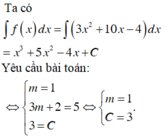Tìm nguyên hàm F(x) của hàm số f ( x ) = 3 + cos 4 πx 4 , F ( 4 ) = 2




Hãy nhập câu hỏi của bạn vào đây, nếu là tài khoản VIP, bạn sẽ được ưu tiên trả lời.

Biến đổi :
\(4\sin x+3\cos x=A\left(\sin x+2\cos x\right)+B\left(\cos x-2\sin x\right)=\left(A-2B\right)\sin x+\left(2A+B\right)\cos x\)
Đồng nhất hệ số hai tử số, ta có :
\(\begin{cases}A-2B=4\\2A+B=3\end{cases}\)\(\Leftrightarrow\begin{cases}A=2\\B=-1\end{cases}\)
Khi đó \(f\left(x\right)=\frac{2\left(\left(\sin x+2\cos x\right)\right)-\left(\left(\sin x-2\cos x\right)\right)}{\left(\sin x+2\cos x\right)}=2-\frac{\cos x-2\sin x}{\sin x+2\cos x}\)
Do đó,
\(F\left(x\right)=\int f\left(x\right)dx=\int\left(2-\frac{\cos x-2\sin x}{\sin x+2\cos x}\right)dx=2\int dx-\int\frac{\left(\cos x-2\sin x\right)dx}{\sin x+2\cos x}=2x-\ln\left|\sin x+2\cos x\right|+C\)

Biến đổi :
\(4\sin^2x+1=5\sin^2x+\cos^2x=\left(a\sin x+b\cos x\right)\left(\sqrt{3}\sin x+\cos x\right)+c\left(\sin^2x+\cos^2x\right)\)
\(=\left(a\sqrt{3}+c\right)\sin^2x+\left(a+b\sqrt{3}\right)\sin x.\cos x+\left(b+c\right)\cos^2x\)
Đồng nhấtheej số hai tử số
\(\begin{cases}a\sqrt{3}+c=5\\a+b\sqrt{3}=0\\b+c=1\end{cases}\)
\(\Leftrightarrow\) \(\begin{cases}a=\sqrt{3}\\b=-1\\c=2\end{cases}\)


Vậy m =1 là giá trị cần tìm thỏa mãn yêu cầu bài toán.
Đáp án C

Đặt \(f_1\left(x\right)=3e^{2x+1};f_2\left(x\right)=\frac{1}{\cos^{2\left(\frac{\Pi x}{4}\right)}}\) . Khi đó \(f\left(x\right)=f_1\left(x\right)+f_2\left(x\right)\)
- Tìm một nguyên hàm của \(f_1\left(x\right)=3e^{2x+1}\) vì nguyên hàm của hàm số \(e^x\) là hàm số \(e^x\) nên theo quy tắc : "Nếu F(x) là một nguyên hàm của hàm số \(f\left(x\right)\) thì \(F\left(y\left(t\right)\right)\) là một nguyên hàm của hàm số \(f\left(y\left(t\right)\right).y't\) trong đó ta giả thiết rằng các hàm số \(f\left(y\left(t\right)\right).y't\) và \(F\left(y\left(t\right)\right)\) đều được xác định. Đặc biệt là nếu \(y\left(t\right)=at+b,a\ne0\) vafneeus F(x) là một nguyên hàm đối với hàm \(f\left(x\right)\) thì \(\frac{1}{a}F\left(at+b\right)\) là một nguyên hàm đối với hàm số \(f\left(at+b\right)\)" (a)
Nguyên hàm của hàm số \(e^{2x+1}\) là \(F_1\left(x\right)=\frac{1}{2}e^{2x+1}\)
Theo quy tắc "Nếu \(F\left(x\right)\) là một nguyên hàm của hàm số \(f\left(x\right)\) thì \(kF\left(x\right)\) là một nguyên hàm của hàm số \(kf\left(x\right)\)" (b)
một nguyên hàm của \(3e^{2x+1}\) là hàm số \(3.\frac{1}{2}e^{2x+1}=\frac{3}{2}e^{2x+1}\)
Tìm một nguyên hàm của \(f_2\left(x\right)=\frac{1}{\cos^{2\left(\frac{\Pi x}{4}\right)}}\). Vì hàm số \(\tan x\) là một nguyên hàm của \(\frac{1}{\cos^2x}\) nên theo quy tắc (a) ta có \(\frac{4}{\Pi}\tan\frac{\Pi x}{4}\) là nguyên hàm của \(\frac{1}{\cos^{2\left(\frac{\Pi x}{4}\right)}}\)
Bây giờ áp dụng quy tắc "Nếu F(x) là một nguyên hàm của hàm f(x) và G(x) là một nguyên hàm của hàm số g(x) thì hàm số F(x) + G (x) là môt nguyên hàm của hàm số f(x)+g(x)" (c)
ta thu được \(\frac{3}{2}e^{2x+1}+\frac{4}{\Pi}\) là nguyên hàm của hàm số \(f\left(x\right)\)
Mọi nguyên hàm của \(f\left(x\right)\) được biểu diễn bởi công thức :
\(F\left(x\right)=\frac{3}{2}e^{2x+1}+\frac{4}{\Pi}\tan\left(\frac{\Pi x}{4}\right)+C\)
Đáp án B.